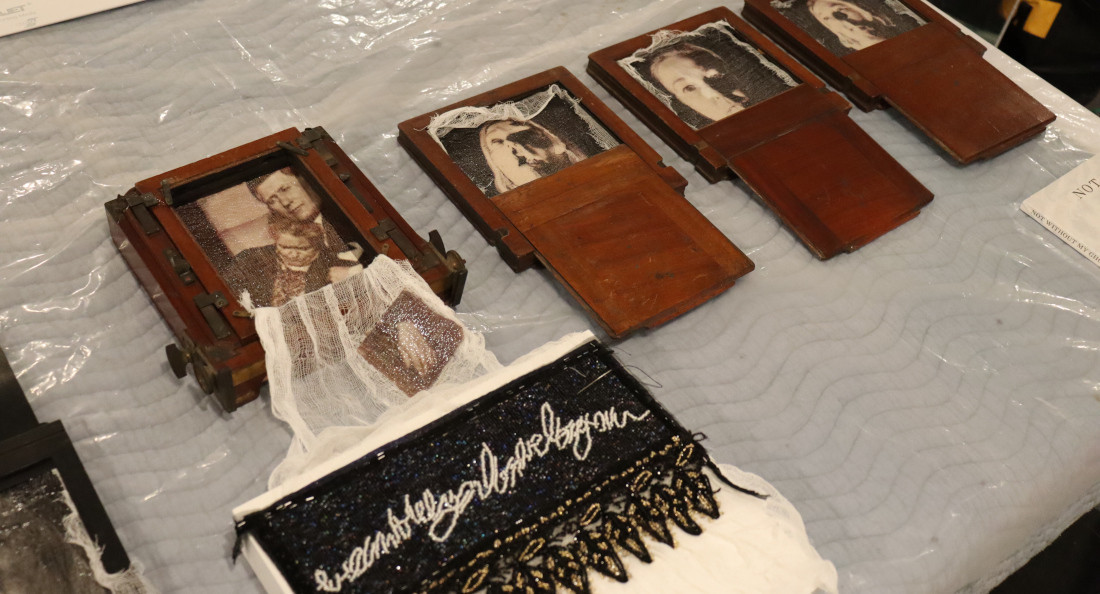1C03 exhibit explores spiritualism, ghosts, pandemics
The Undead Archive reimagines 1930s supernatural photographs
A spectre is haunting Centennial Hall.
The Undead Archive: 100 Years of Photographing Ghosts, a multi-site exhibition curated by University of Winnipeg art-history professor Dr. Serena Keshavjee, opens in Gallery 1C03 on Sept. 7.
It features 25 artists’ photography, textiles and works in other mediums. The Undead Archive is anchored by extensive material from the Hamilton Family Fonds at the University of Manitoba Archives. This material documents Winnipeg couple Dr. Thomas Glendenning (T.G.) and Lillian Hamilton’s obsession with spiritualism in the 1920s and ’30s.
Many contemporary works in the exhibit directly reference or recreate material from the Hamilton archive, whose crown jewel is a series of striking portraits where a thick “ectoplasm” appears to be bursting forth from female subjects’ mouths.
“My theory is that part of the reason that contemporary artists and people like Guy Maddin are interested in these photos is because of (their) modern look,” Keshavjee says.
Maddin, who is featured in the exhibit, included the Hamiltons’ photographs in his 2007 film My Winnipeg.
“Modernist art has clean lines, contrasts and has a scientific look,” Keshavjee says. “Modernist art and science grew up together, and I think there’s an appeal in these photographs because of that semi-minimalist aesthetic.”
She explains that while Lillian first took interest in séances as a parlour game, by 1922 her deepening fascination with spiritualism eventually drew in her husband’s zeal for scientific experimentation.
T.G. then set up the “séance laboratory” where the exhibition’s archival material was produced. The next year, Sherlock Holmes author and psychical researcher Sir Arthur Conan Doyle came to Winnipeg to give a talk titled “Proofs of Immortality,” which the Hamiltons attended.
“Before he gave the talk, Conan Doyle came to Hamilton’s laboratory and sat in it,” Keshavjee says. “There’s paragraphs in (Doyle’s memoirs) about the table charging through the air, flying. He couldn’t contain it. It was so powerful. It was like a restless dog.”
The Undead Archive foregrounds the personal and collective historical contexts in which both the archival material and the contemporary works were produced. The Hamiltons’ son died in the 1919 influenza pandemic, as did many of T.G.’s patients.
Many of the exhibitions’ contemporary pieces call direct attention to the parallels between that pandemic and the collective experience of COVID-19.
Northern Manitoban artist teresa burrows produced her extensive contributions to The Undead Archive during lockdowns in 2020 and 2021.
“I was lucky, because I was locked in the north, and I had nothing but my wild senses to just go at it,” burrows says.
She hopes that her work, which includes a mixed-media piece depicting Canada’s chief public health officer Dr. Theresa Tam, can help challenge the devaluation of craft as a legitimate art form.
“When I tell people I do beadwork, they simply assume I’m either doing jewelry or moccasins. I’m not doing a beadwork that would necessarily be a comment on the past and a voice for the future,” burrows says.
The Undead Archive runs in Gallery 1C03 until Nov. 10. There will be a three-part opening reception at 1C03 on Sept. 21, including a bus tour shuttling guests to the exhibition’s other two sites at the University of Manitoba.
Published in Volume 78, Number 01 of The Uniter (September 7, 2023)






